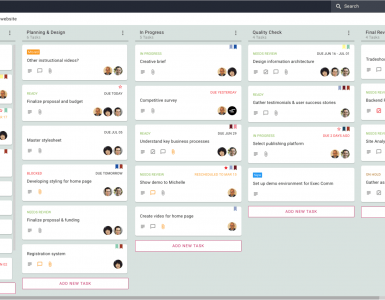It’s predicted that approximately 27 million Americans will report freelancing as their primary source of income in 2020. That’s almost double the number from previous years, perhaps driven largely by the impacts of COVID-19 on many traditional small businesses.
As workers transition from employment to freelance life, one of the major challenges they may face is cash flow. Studies show that 35% of freelancers struggle significantly with money and 25% of freelance businesses under two years old regularly face cash flow challenges.
While some other types of businesses can improve cash flow by raising prices or moving inventory, such tactics don’t work for writers and other independent contractors. As a freelancer, here are six ways you can improve and manage your cash flow.
1. Be Clear On Your Contract Terms
Your contracts, whether drafted by yourself or provided by your client, can have a big impact on your cash flow. Terms are especially important to clarify, such as how frequently you can invoice and when payments are due.
Can you invoice every two weeks or upon project completion? That may be better for your cash flow than having to wait until the end of the month. You may also want to build in other items such as kill fees, late fees, milestone payments, and so on.
The skill is to avoid any ambiguity in the contract so that both parties are clear about what’s expected and what should happen if the contract is cancelled, you are paid late, or scope creep is introduced to the engagement.
It’s easier to make such changes to your contact at the beginning of your relationship with the client. That’s when you have the most leverage, since your client is eager to start the project and may be willing to make some tweaks to accommodate your demands.
2. Invoice Promptly & Keep Records
A big reason for cash flow woes among freelancers is not getting paid on time. Most clients have payment terms of 30, 45, or even 60-days. In addition, many clients still pay by check which can easily add another week to the process. A survey by Bill.com found that 54% of freelancers say it takes too long to get their money and 45% say clients don’t pay them on time.
You can help minimize delays by invoicing promptly and accurately. If your contract permits (see above), don’t wait until the end of the month to invoice. Either bill once the project is complete or invoice every two weeks or as often as you’re allowed.
To help eliminate client confusion or pushback, always include as much detail as you can on your invoice. Detail the hours you worked, your hourly rate, a PO number if issued, project specifics, and the name of your client point of contact so that accounts payable knows who to turn to for approvals. Most importantly, include your payment terms. This will give you extra leverage to chase late payments.
Finally, keep a spreadsheet of all submitted invoices. Record the date, invoice number, client, amount, and project specifics and if payment has been received. Check your spreadsheet regularly and chase any amounts that are past due.
3. Set Money Aside For Your Estimated Taxes
Estimated taxes are paid quarterly to the federal and state government. Yet many new freelancers aren’t aware that they are required to make these payments as they go and are caught with a hefty tax bill at the end of the year.
Even seasoned freelancers can get caught out if they don’t plan for those quarterly payments and find themselves with an unexpected cash flow crisis.
The most efficient way to avoid both scenarios is to save as you go. Instead of pocketing your earnings and spending it all, consider opening a separate bank account and depositing 30-35% of your revenue each month or on a schedule that works for you. You can then draw on this cash to pay your estimated taxes without feeling the pinch.
4. Consider Forming An S Corporation
Most freelancers operate as sole proprietorships, and, while the administrative burden may be minimal, the tax obligation can be significant. Sole proprietors pay 100% of their self-employment taxes and are taxed on all profits of the business, less deductible expenses – this can put a huge strain on your cash resources.
Forming your business as a limited liability company (LLC) and electing to become an S corporation in the eyes of the IRS could help you realize savings. When structured as an S corporation, as the business owner, you are treated as an employee and draw a salary from the profits of your business.
In this scenario, only your wages are subject to self-employment tax. The remaining profits are then distributed to you as dividends on which you pay personal income tax.
An S corporation is not right for every freelancer. It all really depends on your income level, the tax bracket you occupy, and willingness to deal with the additional paperwork and state fees. You may also need to retain the services of a tax advisor or accountant to help you meet all your administrative responsibilities. Talk to a pro before you make the leap.
5. Consider An SEP Retirement Plan (To Lower Your Tax Burden)
Although it’s first and foremost a retirement strategy, a Simplified Employee Pension (SEP) Plan or SEP-IRA can also help freelancers reduce taxable income and preserve cash.
Unlike a traditional IRA, an SEP lets you contribute more to the plan each year—up to 25% of your total income or $57,000 (refer to the IRS for the latest contribution limits). Compare that to the current IRA limit of $6,000 ($7,000 if you are 50 or older).
Another nice benefit of an SEP is that you can vary your contributions for the tax year up until tax-day. If you have a profitable month, go ahead and put more money into your SEP (as long as you don’t go over the limit). Plus, all those contributions are tax deductible, potentially helping your cash flow situation.
6. Use A Line Of Credit As Your Safety Net
Every freelancer needs a safety net. But if you don’t have enough savings to tide you over when cash flow is tight, consider applying for a business line of credit.
A business line of credit is a useful tool that can help freelancers overcome cash flow gaps without the complications that come with a more traditional bank loan. You can borrow a pre-agreed amount of money from a financial institution when you need it and repay back when you don’t.
For example, with Fundbox you can apply online and get a decision in minutes. If approved, you can draw on funds anytime you need them and have them transferred to your account as soon as the next business day. Plus, if you pay back early you save and there’s no impact to your credit score just for applying.
You also don’t have to use the money right away you can simply have the line of credit on hand as a safety net for when unexpected cash flow issues arise. Unlike a business loan you can also use the funds for any purpose – paying bills, marketing, and so on.
Always Have An Eye On Cash Flow
Freelancing can be a busy and stressful business, but following these best practices can help reduce the impact of cash flow issues. With careful planning you can offset the common cash flow pitfalls of being a freelancer and be more comfortable and successful for it.
Fundbox and its affiliates do not provide tax, legal or accounting advice. This material has been prepared for informational purposes only, and is not intended to provide, and should not be relied on for, tax, legal or accounting advice. You should consult your own tax, legal and accounting advisors before engaging in any transaction.










